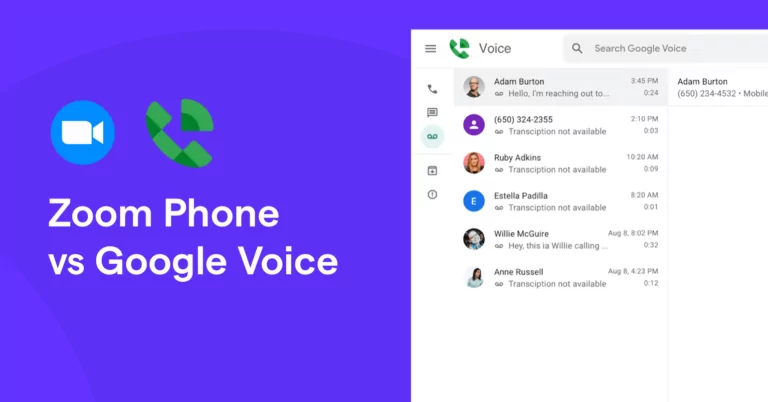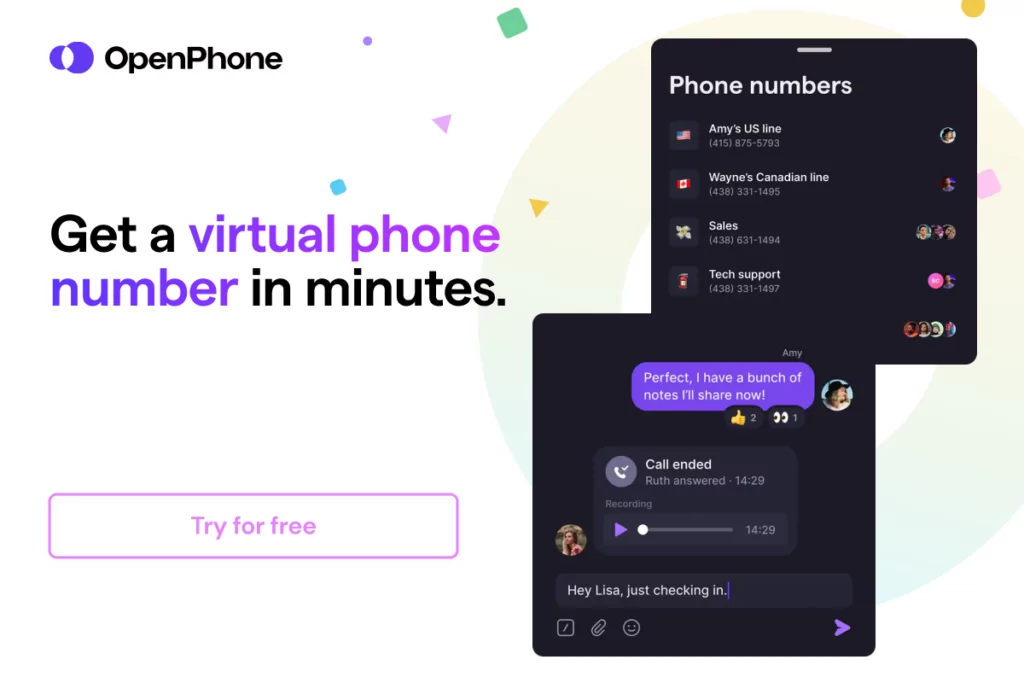Trying to compare Zoom Phone vs Google Voice? Their biggest difference is the price tag — Google Voice’s personal plan is free, but Zoom Phone is not.
That’s hardly the end of the story. If you look closer at Google Voice vs Zoom Phone’s features and integrations, you’ll see a number of differences that could impact your business. And once you start to familiarize yourself with their unique limitations, you may realize neither platform offers the features your business needs.
Let’s dive a little deeper by comparing Zoom Phone vs Google Voice on their prices, features, and integrations. And don’t worry: if you don’t like what you see, we’ll suggest a third phone system that comes with fewer limitations.
Zoom Phone vs Google Voice: How do they measure up?
Zoom Phone and Google Voice both provide business phone numbers — but beyond a few basic features and issues with managing conversations (more on this later), that’s where their similarities end. Each platform has its own features, price tiers, and limitations, all of which you should know before making any rash decisions.
Let’s compare Zoom Phone vs Google Voice based on prices, features, and third-party integrations:
1. Pricing: Which VoIP solution gives you the most bang for your buck?
Winner: Google Voice
It’s no surprise that Google Voice wins this round — after all, GV’s personal plans are free. However, Google Voice’s free tier wasn’t designed to manage business calls and significantly restricts how much you can do unless you pay for an official Google Voice plan.
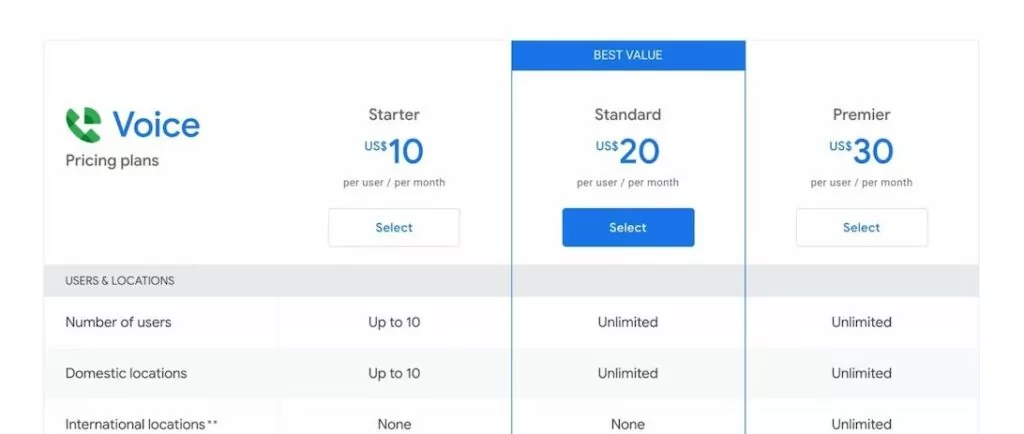
Google Voice for business has three price tiers: Starter ($10 per month per user), Standard ($20 per month per user), and Premier ($30 per month per user). You’ll also need an active Google Workspace account to access Google Voice (an extra $6 per month). Even on the lowest tier, you’ll be spending $16 per month per user just to access your VoIP phone number.
There are other costs to consider as well. The Starter plan only lets you have up to 10 users and 10 phone numbers, so you’ll have to upgrade to the Standard plan if you want more users or additional phone numbers.
Keep in mind also Google Voice is only available in 14 countries:
- Belgium
- Canada
- Denmark
- France
- Germany
- Ireland
- Italy
- Netherlands
- Portugal
- Spain
- Sweden
- Switzerland
- United Kingdom
- United States
If you’re outside these areas, you won’t be able to use Google Voice at all.
Unlike Google Voice, Zoom Phone is available in 40+ countries.
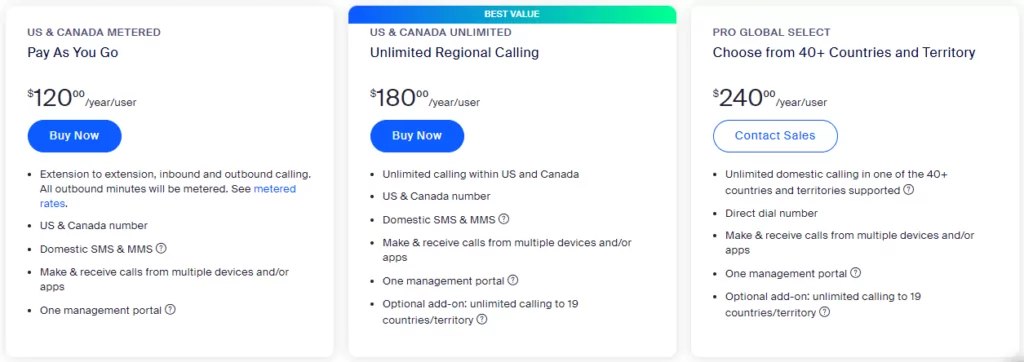
Zoom Phone starts at $10 month/user for Metered plans, $15 month/user for Unlimited plans, and $20 month/user for Select plans. The enterprise-level plan, Pro, requires a custom quote.
You’ll need to upgrade to the Select plan to access international numbers and calls, you won’t be able to send any text messages from this plan. You can’t access all 40+ countries in Zoom Phone’s database at once — no matter how much you upgrade, you’ll only have unlimited domestic calling in one international country of your choice. If you want unlimited calling in up to 19 other countries and territories, you’ll need to purchase the add-on ($120 per year).

Keep in mind if you want a shared phone number with Zoom that you also need a paid Zoom Pro plan — which costs up to $250 per year per user.
If you’re still interested in Zoom Phone, Zoom Phone also provides a few add-on features that you may need to pay for depending on your team’s needs:
- Workspace Reservations (team members can reserve a specific workstation if you have a flexible office environment): ranges from $0 per month to $1.50 per workspace per month
- Additional phone numbers: $60 per year
- Premier developer support [access to API and webhooks] (ranges from $0 per month to $1,900 per month)
- Toll-free numbers ($60 per year)
- International calling add-on ($120 per year)
- Hardware as a Service (starting at $5.99 per month per device)
- Zoom Phone Power Pack (starting at $300 per year per user)
Another major caveat with Zoom Phone: They don’t offer a trial period at all, even if you choose to pay per month.
Even though Google Voice’s plans cost more per month than Zoom Phone, you won’t need to buy as many add-ons or à la carte packages, which will keep your monthly costs much lower.
Both providers still force you to pay extra for video meetings and to have a phone number where your team can split responsibility for incoming calls.
2. Features: Which VoIP service provider has the best phone features?
Winner: Zoom Phone
Both Zoom Phone and Google Voice offer the same essential features:
- Call recording (with Google Voice, you’ll have to pay to upgrade to access this feature)
- Conference calling
- Mobile apps
However, Zoom Phone still pulls ahead of Google Voice when you look at their sheer number of features. Zoom Phone comes with ring groups and auto-attendants (IVR) on the basic plan, while Google Voice requires you to upgrade.
Additionally, Zoom Phone has the added benefit of real-time reporting and quality dashboards, which help you keep an eye on your team’s efficiency and overall performance.
Despite all this, there are some important limitations to keep in mind. Zoom Phone only offers SMS and MMS support for numbers in the US and Canada. You can only use direct numbers (not company, department, or main numbers) to contact customers, which can make it far more difficult to follow up with customers.
It doesn’t help that Zoom Phone only offers basic texting support. If you want to save some time with auto-replies, snippets, or scheduled messages, you’ll have to dig into their API and create your workflow from scratch — which as you remember, costs up to $1,900 per month.
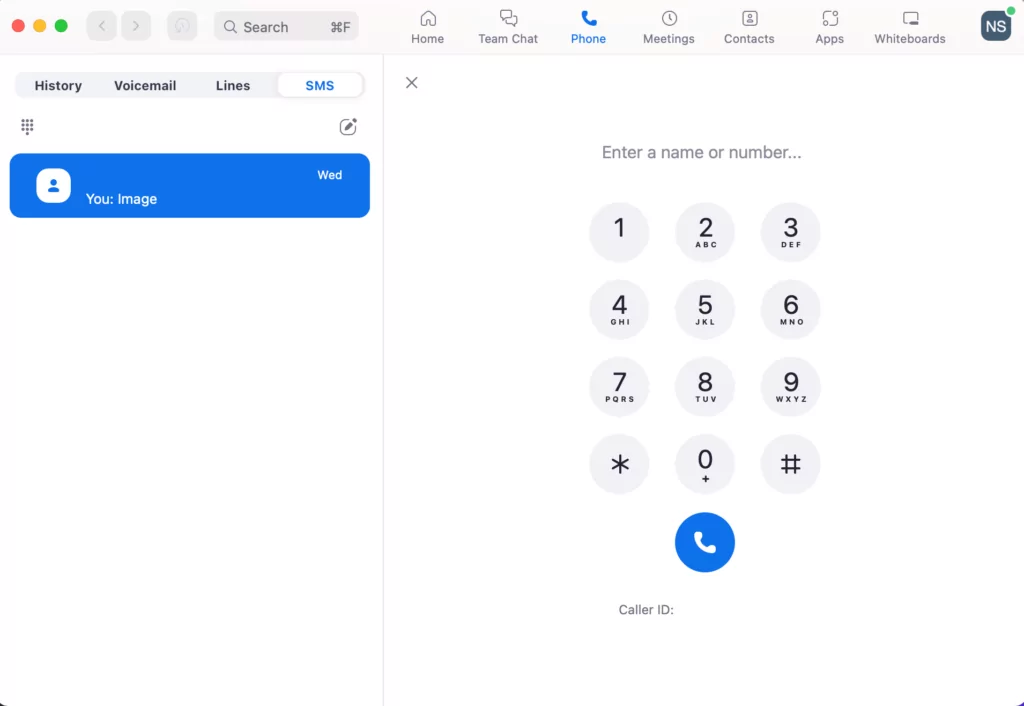
Zoom Phone is also difficult to navigate and catch up on conversations. On their desktop app, all calls, voicemails, and text messages live in separate folders. Although Zoom doesn’t have a browser app, you’ll need to log in from your browser to update some settings. And when you do need to add or change settings, most things aren’t easy to update.
Additionally, there’s no way for you to assign tasks to different team members or work together from a shared inbox. This makes collaboration hard to do without integrations and stops you from delivering the best service to callers.
Finally, but perhaps most importantly, Zoom Phone doesn’t provide unlimited calls and texts on all plans. Internal communications are always free, but unless you purchase the Unlimited or Select plan, you’ll have to pay for all outbound calls and texts. You won’t want to upgrade too much, though: their Pro enterprise plan still meters all outbound calls.
Google Voice provides unlimited inbound and outbound calls to customers on their Starter plan. However, if you have a distributed team with coworkers outside the US, you’ll need to pay for the highest tier ($30 per month per user) to unlock international locations.
Speaking of collaboration, Google Voice is fairly limited in terms of shared access. Google Voice’s free version doesn’t support collaboration at all, since it’s built for individual users. If you decide to get a paid plan with Google Voice for Google Workspace, you can only share responsibility for incoming calls — and only if you’re on the Standard plan or higher.
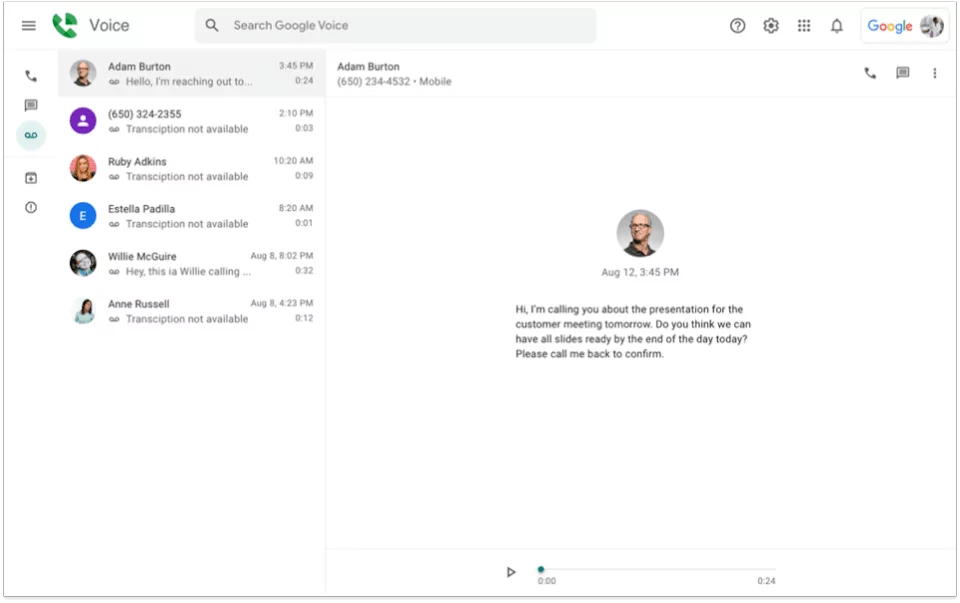
Even then, like Zoom Phone, all of your calls, texts, and voicemails are in separate inboxes. This makes jumping into any conversation far more difficult and requires your team to review caller histories inbox by inbox.
You’ll notice Google Voice locks some of its best features behind more expensive plans. Call recording, for example, is only available on the Standard plan. If you want multi-level auto-attendants or ring groups, you’ll need to pay for the second tier or higher. But no matter how much you upgrade, you won’t be able to send auto-replies or even text at all if you’re not based in the US. Text messaging is only available to US customers.
There may be fewer limitations with Google Voice than Zoom Phone, but if you need more robust features with better team collaboration tools, Zoom wins by a slim margin.
3. Integrations: Which phone service supports the most third-party apps?
Winner: Zoom Phone
Zoom Phone is easily the winner of this round. The platform directly integrates with five different apps, including Salesforce, Slack, Microsoft Outlook, Google Calendar, and Gmail. They also integrate with five additional contact center tools: Five9, Twilio, Genesys, NICE inContact, and Talkdesk. You could try to use webhooks or the Zoom API to tap into other apps, but you’ll need a developer on your team or experience with coding to get started.
Google Voice is much less robust. Even on the highest tier, the platform only integrates with other Google apps like Google Meet, Google Drive, Google Calendar, and Gmail.
You could still use Google Voice for basic business calls. However, you won’t have the convenience of integrating with your pre-existing tools or platforms.
Why OpenPhone is the best alternative to Google Voice & Zoom Phone
At this point in our comparison, you may be seriously reconsidering your options for a business phone system. As you’ve seen, Google Voice is extremely limited and not originally designed for business use, and Zoom Phone targets much larger businesses with a high price tag to prove it.
You need a business phone system that’s easy to get up and running and can scale alongside your company as it grows and matures. Most importantly, you need a system actually designed for growing businesses, and not just global enterprises.
That’s where OpenPhone comes in.
1. OpenPhone offers the most flexible plans
OpenPhone understands that flexibility is important for fast-growing teams. That’s why we make it easy to scale your business phone system.
Unlike Google Voice, OpenPhone doesn’t force you to upgrade once your team reaches a certain size. And unlike Zoom Phone, you’re welcome to give us a try before you commit to a plan. You can take OpenPhone for a spin with a seven-day free trial at any time.
If you’re like most other former Google Voice and Zoom Phone customers, you’ll find during your free trial it’s much easier to customize your phone settings.
With OpenPhone, you can easily share a single business number with your entire team. You’re also welcome to give everyone their very own number. Every user on your OpenPhone plan comes with one free US, Canadian, or toll-free number that can be used anywhere you have an internet connection. Any additional numbers are $5 each per month.
Plus, OpenPhone doesn’t believe in nasty surprises. We offer totally transparent pricing plans that list all rates and fees in a single, easy-to-view format. You can check our international call and text rates and applicable fees right from our pricing page.
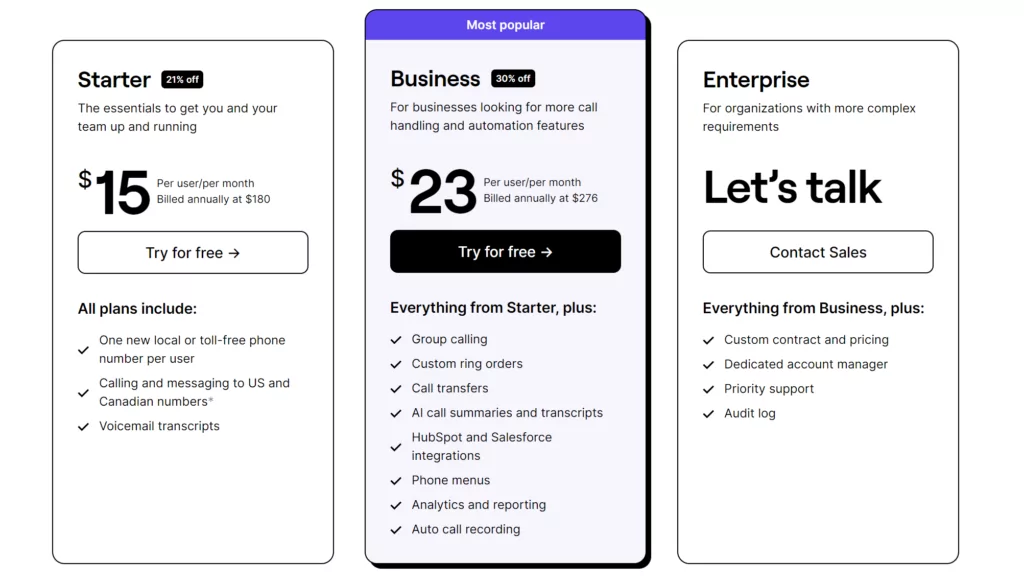
We offer three distinct plans:
Starter
- $15 per month per user
- Access free calls and texts to US and Canadian numbers, voicemail to text, call recordings, and more
Business
- $23 per month per user
- Unlocks call transfers, analytics, and our HubSpot and Salesforce integrations
Enterprise
- A custom price for a custom plan
- Enjoy audit logs, priority support, and a dedicated account manager
2. Work together with your team
Older phone platforms just aren’t built for collaboration. Luckily, OpenPhone has turned the past completely on its head.
With OpenPhone’s shared numbers, any team can split responsibility for responding to incoming calls and messages. And unlike Zoom Phone or Google Voice, anyone on your team can text from a shared number. You never need to worry about a busy line — multiple members of your team can make or take separate calls at the same time.
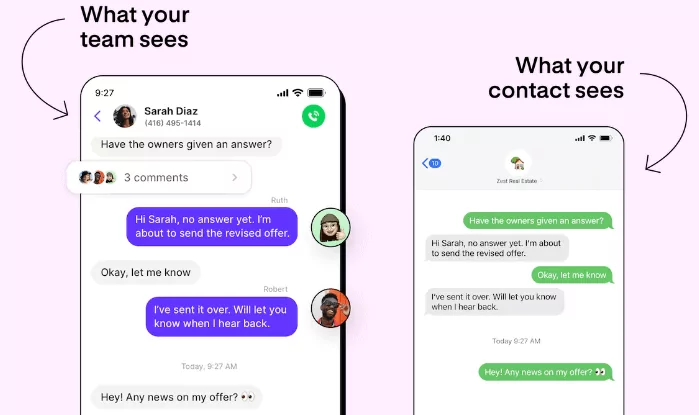
You can also collaborate inside of your contact’s messages with internal threads and mentions. With threads, you can easily leave notes on any conversation to give other teammates additional context. Mentions allow you to tag someone inside a conversation to collaborate on a response or assign out a task. And don’t worry; your contacts can’t see these threads or mentions at all!
3. Catch up on conversations faster
With OpenPhone, all call recordings, voice messages, and texts are in a single conversation thread for each contact so you can easily follow up. If you’re managing a team, you can easily see who on your team has been in touch with a contact or check the status of a conversation to tag in a teammate.
4. Easily build your work relationships over texting
Say goodbye to basic SMS support, and hello to OpenPhone’s powerful texting features that save time and effort for everyone on your team.
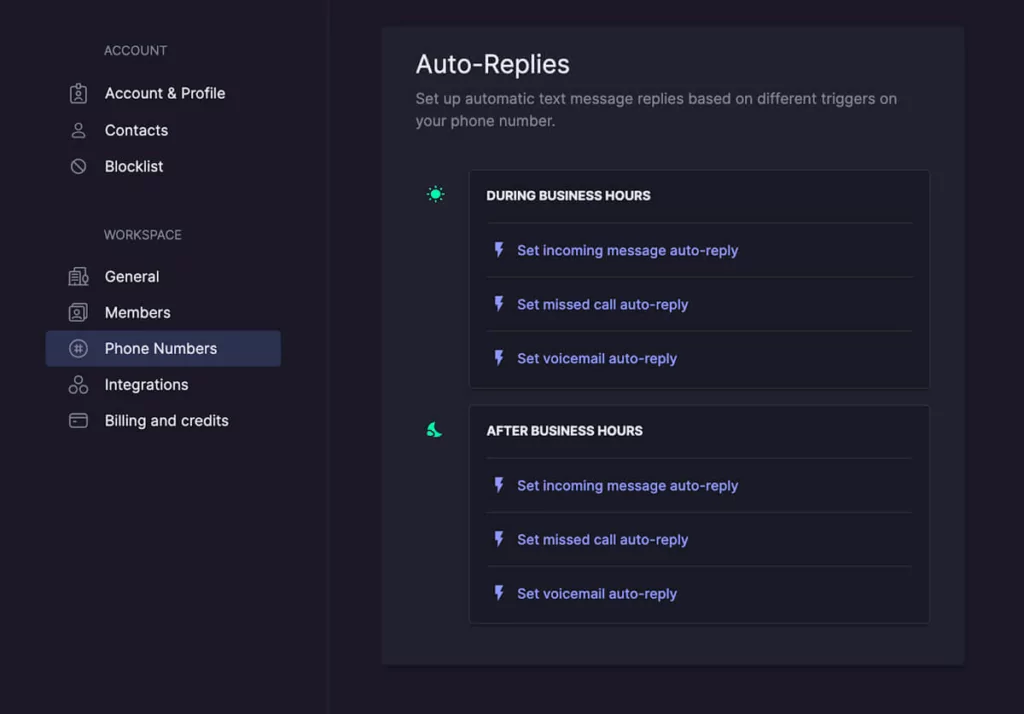
OpenPhone users can set up auto-replies that instantly respond to customers when you’re busy or off the clock. Let callers know you’re out of the office, give them your business hours, and quickly address important needs without diverting your attention from other tasks.
You can also use snippets to quickly answer FAQs. Just write up your message template and save it in our system, then type ‘/’ to select and send it again in the future. Everyone on your team can now send consistent info to callers and clients, and save even more time while doing so.
OpenPhone makes it easy to send messages on whatever schedule works for you. Need to send a text message at a later date? Just use our scheduled messages feature to queue up a time for your text to send. Customers will get your reply right on schedule, and you can stay focused on mission-critical tasks.
5. Connect other apps in your tech stack without needing a developer
You don’t need to be a developer to integrate your tech stack with OpenPhone. We directly integrate with tools and systems used by thousands of modern companies, including Slack, HubSpot, Salesforce, and Google Contacts.
Plus, with our Zapier integration, you can connect OpenPhone to more than 3,000 other apps.
Getting started is easy — we have a massive library of support docs and tutorials that can help you navigate getting started with integrations and any other features. Reach out to us if you need any help.
Zoom Phone vs Google Voice vs OpenPhone comparison table
Are you interested to see how OpenPhone compares to Zoom Phone and Google Voice? Check out all the prices, features, and integrations at a glance.
| OpenPhone | Zoom Phone | Google Voice | |
|---|---|---|---|
| Pricing | Starts at $15 per user per month | Starts at $10 per user per month | Starts at $16 per user per month (including Workspace subscription) |
| Unlimited calling to US & Canada | ✓ | Unlimited inbound only with upgrade | X |
| SMS, MMS | ✓ | US & Canadian numbers only | ✓ |
| Voicemail transcriptions | ✓ | ✓ | ✓ |
| Business hour settings | ✓ | ✓ | ✓ |
| Additional phone numbers | $5 per number per month | $5 per number per month | x |
| Call recording | ✓ | ✓ | X |
| Shared phone numbers | ✓ | Shared line appearance / delegation only | Requires upgrade (ring groups only) |
| Auto-attendant (virtual receptionist) | ✓ | ✓ | Requires upgrade |
| Auto-replies | ✓ | X | X |
| Slack integration | ✓ | X | X |
| Zapier integration | ✓ | X | X |
| CRM integration | Requires upgrade | X | X |
| iOS and Android apps | ✓ | ✓ | ✓ |
| Browser app | ✓ | X | ✓ |
| Desktop apps | ✓ | ✓ | X |
Zoom Phone vs Google Voice: OpenPhone is the clear winner
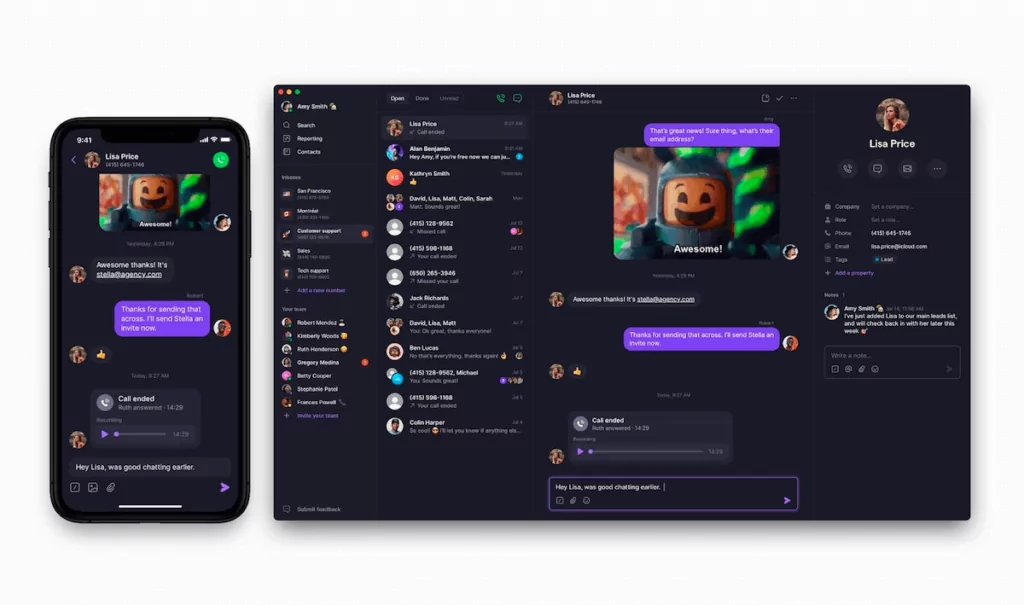
OpenPhone is the preferred business communication solution for customers around the world. We make it easier to build relationships with your customers and add team members as your company grows.
And with a seven-day trial available, you can see how much flat-out simpler OpenPhone is to use.
Sign up today to try OpenPhone free for seven days. When you’re ready, you can easily move any existing number to OpenPhone from the web or desktop.
